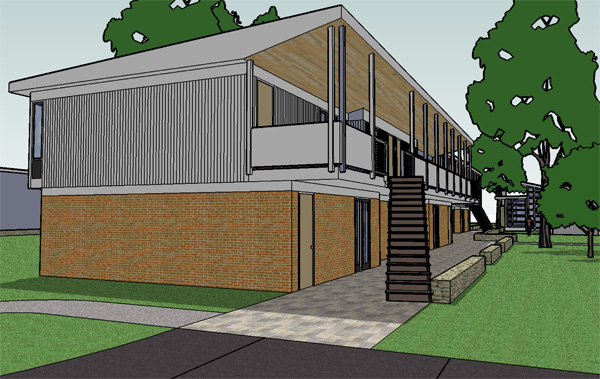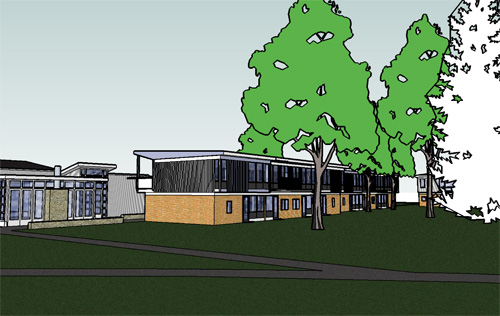Campus Housing - Short-term Academic Housing
Annually, some 190 visiting Members from about one hundred universities and research institutions throughout the world are invited to the Institute to hone their skills and do their best work, guided by a permanent Faculty of no more than twenty-eight eminent scholars. One of the defining aspects of the Institute is its existence as a strongly residential community of scholars. This factor is essential in maintaining the level and intensity of intellectual exchange that occurs across the range of study in the sciences and humanities at the Institute.
In the early years of the Institute, Members were housed in private apartments found throughout Princeton Borough. After World War II, Princeton experienced significant population growth and an increase in housing costs, making it difficult and expensive to rely on private apartment rentals to house all Members. There was a demonstrated need for a long-term, comprehensive housing plan, and the creation of a residential community on campus.
Marcel Breuer Buildings
The Institute undertook a significant project in 1957 with the construction of 107 studio, one, two and three bedroom apartments in twenty-two buildings. These buildings, designed by Marcel Breuer, were recognized for their functionality and achieved a high degree of comfort and practicality at a reasonable cost. In addition, they accomplished the much needed purpose of bringing Members together in such a way that they had freedom and ease of contact, not only during normal working hours, but also during other moments of intellectual creativity. A second housing expansion, built in the mid-1960s and designed by Princeton architect Thaddeus Longstreth, was an updated facsimile of the Breuer units and significantly expanded the number of Member apartments. A third expansion occurred in the mid-1980s, and finally a major renovation and further expansion occurred in the late-1990s with the demolition of seven buildings, the addition of a second floor to six of the remaining buildings, and a reconfiguration of units to achieve the existing mix of apartment sizes.
Need for Short-term Housing
The current profile of Member and Visitor housing includes 169 apartments in twenty-one buildings, and a guest residence, Marquand House. While the Institute has benefited significantly from the availability of on-campus Member housing over the years, several factors have emerged which generate a need to once again increase overall housing capacity and rebalance the mix of available units to include a larger proportion of small apartments.
 |
| South-west view of proposed short-term Visitor housing |
It is the housing need of short-term Visitors that guides thinking on how to meet the need to increase overall capacity. In 2007, Faculty and Members were joined by some 440 short-term Visitors, whose stay averaged six nights. These Visitors, on site for an academic conference or at the invitation of a Faculty member, are housed in apartments scattered across the residential campus. A Residence specially designed to accommodate short-term Visitors would dramatically improve both the academic and social qualities of the conference or brief academic visit, while allowing the Institute to consolidate its staff and services to better meet their needs. With the addition of a dedicated Visitors’ Residence, the apartments currently held in reserve for short-term Visitors can be released into the pool available for Members. This will improve the efficiency of Member apartment allocations and create the capacity needed to accommodate growth in the School of Natural Sciences and the School of Social Science.
Housing Plans
 |
| North-west view of proposed short-term Visitor housin |
The entire plan for the Visitors’ Residence complex consists of three new apartment buildings with nineteen apartments and a Commons building, providing meeting, reception, and social space. The Institute has appointed the Princeton, New Jersey firm of Holt Morgan Russell Architects, P.A., to develop plans for the Visitors’ Residence. Each of the nineteen apartment units are approximately 580 square feet and contain one bedroom, bathroom, living room, and an open entry area. Parking meets all statutory requirements, with spaces for each unit, in addition to two handicapped spaces and one for service, for a total of twenty-two.
Phase one will consist of buildings A and B, a two-level, two-building structure, with fourteen one-bedroom apartments, and rooms for housekeeping and telecommunications equipment (9,975 square feet). Phase two will include building C and a commons building, the first a two-level structure, with five one-bedroom apartments and the second a single level building. The first level of building C will have two apartment units separated by a protected courtyard; the second level will have three apartment units (2,231 square feet). The commons building will encourage the continuation of scholarly and social discourse outside a formal conference agenda. Current plans call for a central foyer/gallery, a sitting room with fireplace, a meeting/seminar room that can also be set for dining, and associated support space (3,401 square feet).